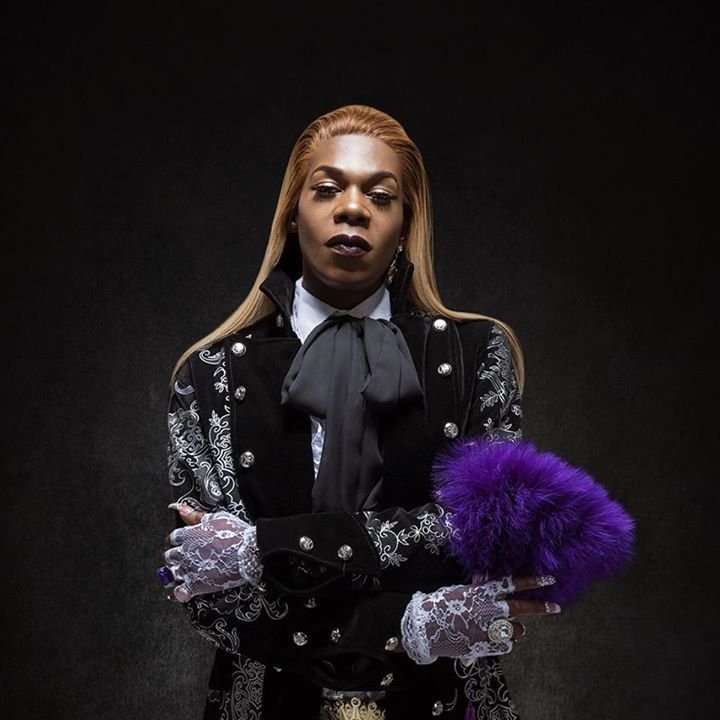Tank and the Bangas Don't Compromise at Jazz Fest

On Saturday at Jazz Fest, Tank and the Bangas and Big Freedia were rock stars, Stevie had sound issues, and Meghan Trainor skewed a little too young.
On Saturday at Jazz Fest, Tank and the Bangas didn’t give an inch. They could have put on their most audience-friendly face and presented themselves as humble musicians on stage at the Fair Grounds to simply play some music and make people happy. Instead, They opened with a Frank Zappa-like instrumental while dancers in blue and green body stockings performed synchronized movements with balls—all before Tank joined them in face paint on the Gentilly Stage. The music was dense and challenging, but it didn’t noticeably shake the crowd, most of whom showed up at the stage specifically for the band. (After the set, it was clear that stage closer Meghan Trainor didn’t inspire many fans to set up camp at that stage.)
The set never exactly calmed down, but eventually took a more familiar shape with Tank playful between bursts of tongue-twisting spoken word, and the songs were more familiar, including the first song from their NPR Tiny Desk Concert, "Boxes and Squares," and “Quick,” the single they released that day. Throughout, it was impossible not to be impressed by the musicianship, but more than that, by the clear freedom the band feels to be itself. It has an obvious future, and it’s intriguing to think about what it might be. One friend thought it would be great to hear Tank and the Bangas produced by tUnE-yArDs, while I thought about how well they would fit in Janelle Monae’s Wondaland Arts Society.
Whatever they do next, it was clear Saturday that it won’t be a choice made out of fear.
Also on Saturday
- Big Freedia has become a rock star. The crowd at Congo Square wasn’t just happy to see her when she walked onstage; people screamed. The substance of what Freedia does hasn’t changed meaningfully over the years, but what has been fun to watch is how she figured out how to make bounce into a concert act. When she started, she and her dancers exploded on to the stage, twerked for a song or two, had some kind of dance off, then invited audience members onstage to twerk as well. Everything she had to do was done in 20 or so minutes, and she wasn’t alone in that. That format had been the standard bounce set, which had great energy and integrity, but it didn’t fit in the live music marketplace outside of New Orleans, where opening sets are between 45 minutes and an hour, and headliners range from an hour to two hours.
Freedia stretched her show by letting the pleasures unfold more gradually. She is part of the choreography that goes on around her, but Freedia is a vocalist first and gradually becomes more of a dancer as the show goes on. It helps that her dancers are also better, able to do more than simply shake backsides. They’re not slick, but the set no longer looks like a block party.
Freedia’s choice to integrate herself into the show more gradually does a lot of positive things, one of the simplest being that she’s not winded from dancing, so her voice is even more powerful and she’s better able to enunciate the percussive syllables she fires off at machine gun speed. She also builds her own image as the Queen Diva because, after all, what queen dances with the commoners without at least a little coaxing?
- I assume Meghan Trainor was booked to seed the next generation of Jazz Fest fans, but judging by the people who seemed to be happiest at her set, a bouncy castle would have done the trick.
- For most of my review of Stevie Wonder, see my coverage at USAToday.com. One thing I didn’t include was how startlingly bad the sound was for Wonder’s set. The drummer spent a lot time early on the ride cymbal—nothing the soundman can do about that—but that cymbal shouldn’t come out of the speakers sounding like frying bacon. The distortion and waver was problematic, as was how prominent it was in the mix. On the other hand, the guitar was absent from the mix and the bass was an amorphous haze of low-frequency sound. I checked it right in front of the stage and again in the bleachers to see if I simply had a bad relationship to the speakers, and the problem was the same. I asked a friend in the bleachers how the sound was for him, and he said it was fine up at the top.
I imagine that working sound at Acura is a tough gig, but since we hear better sound at Gentilly, it seems like it can and certainly should be better.






